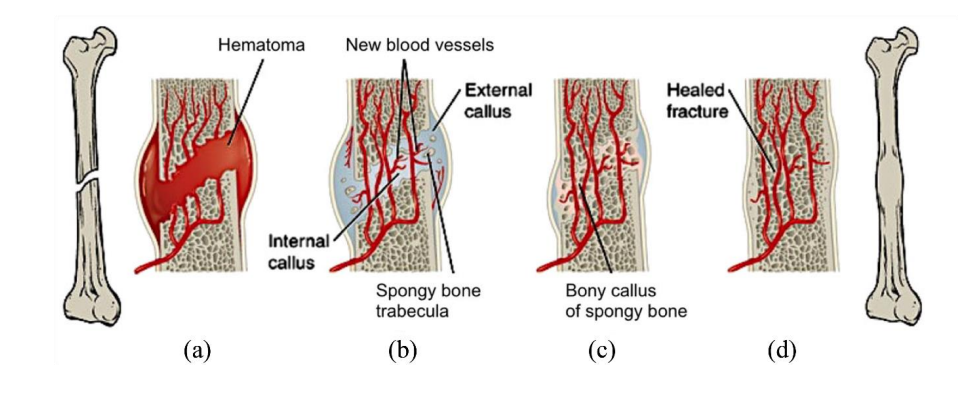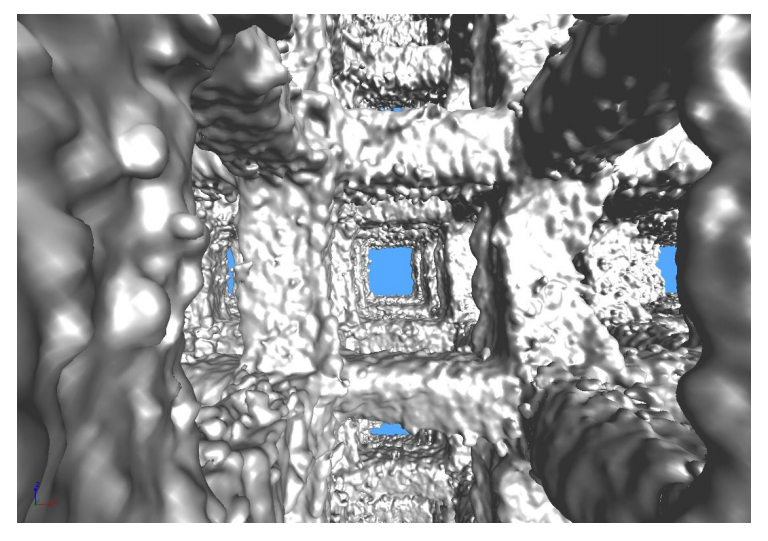In ‘Bone Regeneration on Implants of Titanium Alloys Produced By Laser Powder Bed Fusion: A Review,” the authors examine the continued potential for titanium in bioprinting, as this metal continues to progress in use for the medical field. Pointing out that ‘extensive work’ has been performed in this area, the authors take time to pinpoint areas open for future work, with an emphasis on bone regeneration.
Because titanium has been researched so thoroughly and is in such wide use today, the authors point out it is no secret that these types of metal implants can be produced successfully in 3D printing and additive manufacturing—with laser powder bed fusion (LPBF) offering the greatest benefits. The reviewers are specifically interested in Ti and Ti6Al4V implants, and details required for osseointegration.

Bone regeneration processes occurring due to bone fracture in absence of an implant: (a) break event followed by blood clot formation, (b) new blood vessels formed, followed by osteoinduction – differentiation of cells into osteoblasts and formation of ectopic bone, (c) osteogenesis or formation of new bone through osteoinduction, creating new trabecular and cortical bone; (d) completed process and healed fracture (Hasan et al., 2018).
Bone regeneration occurs through the following:
- Osteogenesis – bone formation.
- Osteoinduction – undifferentiated mesenchymal cells are transformed into osteoblasts; ectopic bone is formed in vivo.
- Osteoconduction – bone growth on bio-inert matrices, allowing for new cell colonization.
The bone healing process can be extensive too, beginning with a blood clot forming around the fracture, then new blood vessels forming, new bone formation, and then ‘the remodeling phase,’ which can even take years. For titanium alloys, the reviewers point out that fabrication of a porous structure causes such a reduction of the elastic modulus that the implant becomes even more like the bone.
“If this is not the case, the stress-shielding effect causes bone loss and loosening of the implant and failure of the process,” state the researchers. “Besides lowering the elastic modulus, the porous nature allows for bone ingrowth into the structure, further strengthening the bond between implant and existing bone.”
Nutrients must be carried to areas where bone is expected to grow, and there must be enough space for vascularization to occur, with pore spaces that are exactly the right size.
One of the more interesting topics pertains to analysis of biomaterial scaffolds, with a variety of different materials promoting bone growth, such as:
- Ceramics
- Metals
- Polymers
- Composites

Variation of trabecular bone structure by location, in this example from human femur, 26-year-old male
Each of these different materials can also have different impacts on bone regeneration.
“Thus, similar approaches to all materials, porosity and size of the pores cannot be suggested as a general guide. Also loaded/unloaded implants can require different voids in terms of volume and shape,” state the reviewers.
Implants require the following:
- Biocompatibility
- Suitable surface topology
- Proliferation and differentiation
- High porosity providing cell ingrowth and transport of nutrients
- Reliable mechanical properties
Samples created through LPBF can show a wide range of variances due to building strategy, contour, overhangs, and scanning procedures. Manufacturing of lattices brings challenges such as limits in production, a host of possible defects, and issues with size.
Cell adhesion is divided into three different stages, with attachment impacted by factors such as surface structure, texture, wetting, chemical composition, and charge at physiologic pH of implant surface.
“For in vitro studies, 3D cell setup looks more preferable in terms of evaluation of pore size and shape for bone growth,” concluded the reviewers. “For in vivo studies, long-term observation needs with analysis not only of bone ingrowth into the implant, but also analysis of surrounding bone and tissues should be done.”
As 3D printing with metal takes off, titanium is one of the most popular materials, used for innovations like maxillofacial implants, brake components for Bugatti, and even veterinary implants. And that is just one type of metal powder being used, as industrial users seek stronger, more lightweight parts available through additive manufacturing. What do you think of this news? Let us know your thoughts! Join the discussion of this and other 3D printing topics at 3DPrintBoard.com.

Rough surfaces on the inside of a lattice produced by LPBF – inside view by microCT, data from (du Plessis et al., 2018d).
Subscribe to Our Email Newsletter
Stay up-to-date on all the latest news from the 3D printing industry and receive information and offers from third party vendors.
You May Also Like
Gorilla Sports GE’s First 3D Printed Titanium Cast
How do you help a gorilla with a broken arm? Sounds like the start of a bad joke a zookeeper might tell, but it’s an actual dilemma recently faced by...
Nylon 3D Printed Parts Made More Functional with Coatings & Colors
Parts 3D printed from polyamide (PA, Nylon) 12 using powder bed fusion (PBF) are a mainstay in the additive manufacturing (AM) industry. While post-finishing processes have improved the porosity of...
$25M to Back Sintavia’s Largest Expansion of Metal 3D Printing Capacity Since 2019
Sintavia, the digital manufacturing company specializing in mission-critical parts for strategic sectors, announced a $25 million investment to increase its production capacity, the largest expansion to its operations since 2019....
Velo3D Initiates Public Offering in a Bid to Strengthen Financial Foundations and Drive Future Growth
Velo3D (NYSE: VLD) has been among a number of publicly traded 3D printing firms that have attempted to weather the current macroeconomic climate. After posting a challenging financial report for 2023,...
































